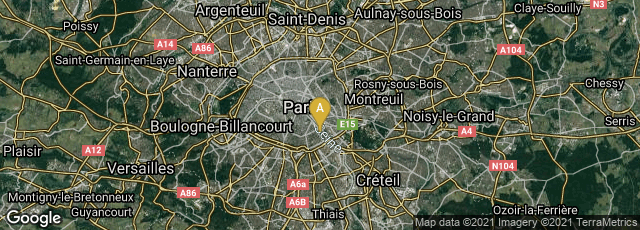

A: Paris, Île-de-France, France
The portfolio of Villard de Honnecourt, preserved in the Bibliothèque nationale de France (MS Fr. 19093), consists of 33 sheets of parchment containing about 250 drawings.
Villard's portfolio ". . . appears to be a model-book, with a wide range of religious and secular figures suitable for sculpture, and architectural plans, elevations and details, ecclesiastical objects and mechanical devices, with copious annotations. Other subjects such as animals and human figures also appear.
"Among the devices Villard sketched is a perpetual-motion machine, a mill-driven saw, a number of automata, one of which depicts a simple escapement mechanism, the first known in the west, lifting devices, war engines as well as a number of anatomical, architectural and geometric sketches for portraiture and architecture.
"Villard apparently traveled through many of the cathedral building-sites in 13th century France and recorded in his sketchbook in great detail work in construction. Of particular interest are drawings of the Laon cathedral bell towers and the Reims cathedral nave being built, which provide a valuable clue for building techniques of High Gothic architecture" (Wikipedia article on Villard de Honnecourt, accessed 08-20-2009).
"Who Villard was, and what he did, must be postulated from his drawings and the textual addenda to them on 26 of the 66 surfaces of the 33 leaves remaining in his portfolio. In these sometimes enigmatic inscriptions Villard gave his name twice (Wilars dehonecort [fol. 1v]; Vilars dehoncort [fol. 15r]), but said nothing of his occupation and claimed not a single artistic creation or monument of any type. He addressed his portfolio, which he termed a 'book,' to no one in particular, saying (fol. 1v) that it contained 'sound advice on the techniques of masonry and on the devices of carpentry . . . and the techniques of representation, its features as the discipline of geometry commands and instructs it.' . . . .
"During a period of perhaps five to fifteen years, Villard made sketches of things he found interesting. At some unknown time in his life, he decided to make his drawings available to an unspecified audience. He arranged them in the sequence he wished, and then inscribed certain of them, or had them inscribed. These inscriptions are all by one professional scribal hand, and fit around the drawings with some care. The language is the basically the Picard dialect of Old French, with some Central French forms rather than Picard forms used consistently, for example, ces and ceus rather than ches and cheus. Occasionally, the different dialects exist side by side: on fol. 32r both the Picard chapieles and Central French capieles, 'chapels,' are found. The inscriptions vary in nature, some being explanations (e.g., fol. 6r: "Of such appearance was the sepulchre of a Saracen I saw one time"), others being instructions (e.g., fol. 30r: 'If you wish to make the strong device one calls a trebuchet, pay attention here').
"The Villard portfolio was rediscovered and first published in the mid-19th century during the height of the Gothic Revival movement in France and England. For this reason, Villard's architectural drawings, which comprise only about 16% of the total, attracted the greatest attention. This led writers to conclude that he was an architect, an assumption based on a fundamental error: the practical, stereotomical formulas on fols.20r and 20v were taken as proof that Villard was a trained mason, and it was not discovered until 1901 that these drawings and their inscriptions are by a later hand.
"Since the 1970s there has been growing suspicion that Villard was not an architect or mason. It has been proposed that he may have been 'a lodge clerk with a flair for drawing' or that his training may have been in metalworking rather than in masonry. The question is not yet resolved, but it may no longer be automatically assumed that he was a mason. It may be that Villard was not a professional craftsman of any type, but simply an inquisitive layman who had an opportunity to travel widely and took the seemingly unusual step of recording some of the things he saw during his travels" (Carl F. Barnes, Jr., "Villard de Honecourt," MacMillian Dictionary of Art, 32 (1996), 569-571).